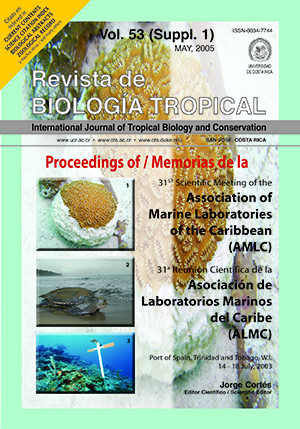Abstract
Welcome Bay and Chaguaramas Bay in the northwest peninsula of Trinidad contain large marinas and smaller sections of bathing beaches. Bacteriological surveys were conducted at both bays to assess water quality and to determine potential sources of pollution. These surveys were conducted during the wet season of 1996 and the dry season of 1997. Eleven sample stations were established at Welcome Bay and 12 at Chaguaramas Bay. Freshwater samples were collected from rivers and drains within the survey area. Marine water samples were collected from marinas, bathing beaches and inshore and outer areas at both bays. Five water samples were collected from each sampling station during the wet season of 1996 and six during the dry season of 1997. The membrane filter technique was used to determine faecal coliform and Escherichia coli levels in all samples. There was a seasonal effect on water quality, with significantly higher faecal coliform levels in the wet season, when water quality was not in compliance with international standards. This represents a potential health risk in bathing areas. Water quality was better at the outer area of both bays. Water quality at the inner bay areas was most likely adversely affected by land-based sources of pollution identified in this study. These sources include three drains and two rivers, which discharged into the bays. Yachts were apparently not a source of sewage pollution: there was no significant relationship between yacht number and faecal coliform levels.References
Anonymous. 1990. Review of potentially harmful substances. Nutrients. Reports and Studies. Group of Experts on the Scientific Aspects of Marine Environmental Protection (GESAMP). GESAMP (34). 40 p.
Beers, J.R., D.M. Steven & J.B. Lewis. 1968. Primary productivity in the Caribbean Sea off Jamaica and the Tropical North Atlantic off Barbados. Bull. Mar. Sci. 18: 86-104.
Dufour, A.P., E.R. Strickland & V.J. Cabelli. 1981. Membrane filter method for enumerating Escherichia coli. Appl. Environ. Microbiol. 14: 1152-1158.
Fujioka, R.S., K. Tenno & S. Kansako. 1988. Naturally occurring faecal coliforms and faecal streptococci in Hawaii’s freshwater streams. Tox. Assess. 3: 613-630.
Hazen, T.C. 1988. Faecal coliforms as indicators on tropical waters: A review. Tox. Assess. 3: 461-477.
Krogh, M. & L. Robinson. 1996. Environmental variables and their association with faecal coliform and faecal streptococci densities at thirteen Sydney beaches. Mar. Poll. Bull. 33: 239-248.
Rivera, S.C., T.C. Hazen & G.A. Toranzos. 1988. Isolation of faecal coliforms from pristine sites in a tropical rain forest. Appl. Environ. Microbiol. 54: 513-517.
United States Environmental Protection Agency (USEPA). 1976. Quality criteria for water. Report No. EAP- 440/9-76-023.
Washington D.C. 501 p. World Health Organization (WHO). 1981. Coastal water quality control in the Mediterranean. Final Report on the Joint WHO / UNEP Co-ordinated Pilot Project (MED – VII) (1976-1980). Geneva. 39 p.
##plugins.facebook.comentarios##

This work is licensed under a Creative Commons Attribution 4.0 International License.
Copyright (c) 2005 Revista de Biología Tropical


